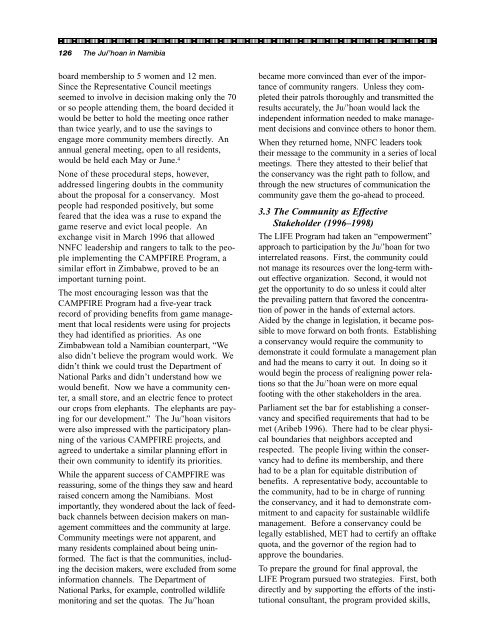Indigenous Peoples and Conservation Organizations
Indigenous Peoples and Conservation Organizations
Indigenous Peoples and Conservation Organizations
You also want an ePaper? Increase the reach of your titles
YUMPU automatically turns print PDFs into web optimized ePapers that Google loves.
126 The Ju/’hoan in Namibia<br />
board membership to 5 women <strong>and</strong> 12 men.<br />
Since the Representative Council meetings<br />
seemed to involve in decision making only the 70<br />
or so people attending them, the board decided it<br />
would be better to hold the meeting once rather<br />
than twice yearly, <strong>and</strong> to use the savings to<br />
engage more community members directly. An<br />
annual general meeting, open to all residents,<br />
would be held each May or June. 4<br />
None of these procedural steps, however,<br />
addressed lingering doubts in the community<br />
about the proposal for a conservancy. Most<br />
people had responded positively, but some<br />
feared that the idea was a ruse to exp<strong>and</strong> the<br />
game reserve <strong>and</strong> evict local people. An<br />
exchange visit in March 1996 that allowed<br />
NNFC leadership <strong>and</strong> rangers to talk to the people<br />
implementing the CAMPFIRE Program, a<br />
similar effort in Zimbabwe, proved to be an<br />
important turning point.<br />
The most encouraging lesson was that the<br />
CAMPFIRE Program had a five-year track<br />
record of providing benefits from game management<br />
that local residents were using for projects<br />
they had identified as priorities. As one<br />
Zimbabwean told a Namibian counterpart, “We<br />
also didn’t believe the program would work. We<br />
didn’t think we could trust the Department of<br />
National Parks <strong>and</strong> didn’t underst<strong>and</strong> how we<br />
would benefit. Now we have a community center,<br />
a small store, <strong>and</strong> an electric fence to protect<br />
our crops from elephants. The elephants are paying<br />
for our development.” The Ju/’hoan visitors<br />
were also impressed with the participatory planning<br />
of the various CAMPFIRE projects, <strong>and</strong><br />
agreed to undertake a similar planning effort in<br />
their own community to identify its priorities.<br />
While the apparent success of CAMPFIRE was<br />
reassuring, some of the things they saw <strong>and</strong> heard<br />
raised concern among the Namibians. Most<br />
importantly, they wondered about the lack of feedback<br />
channels between decision makers on management<br />
committees <strong>and</strong> the community at large.<br />
Community meetings were not apparent, <strong>and</strong><br />
many residents complained about being uninformed.<br />
The fact is that the communities, including<br />
the decision makers, were excluded from some<br />
information channels. The Department of<br />
National Parks, for example, controlled wildlife<br />
monitoring <strong>and</strong> set the quotas. The Ju/’hoan<br />
became more convinced than ever of the importance<br />
of community rangers. Unless they completed<br />
their patrols thoroughly <strong>and</strong> transmitted the<br />
results accurately, the Ju/’hoan would lack the<br />
independent information needed to make management<br />
decisions <strong>and</strong> convince others to honor them.<br />
When they returned home, NNFC leaders took<br />
their message to the community in a series of local<br />
meetings. There they attested to their belief that<br />
the conservancy was the right path to follow, <strong>and</strong><br />
through the new structures of communication the<br />
community gave them the go-ahead to proceed.<br />
3.3 The Community as Effective<br />
Stakeholder (1996–1998)<br />
The LIFE Program had taken an “empowerment”<br />
approach to participation by the Ju/’hoan for two<br />
interrelated reasons. First, the community could<br />
not manage its resources over the long-term without<br />
effective organization. Second, it would not<br />
get the opportunity to do so unless it could alter<br />
the prevailing pattern that favored the concentration<br />
of power in the h<strong>and</strong>s of external actors.<br />
Aided by the change in legislation, it became possible<br />
to move forward on both fronts. Establishing<br />
a conservancy would require the community to<br />
demonstrate it could formulate a management plan<br />
<strong>and</strong> had the means to carry it out. In doing so it<br />
would begin the process of realigning power relations<br />
so that the Ju/’hoan were on more equal<br />
footing with the other stakeholders in the area.<br />
Parliament set the bar for establishing a conservancy<br />
<strong>and</strong> specified requirements that had to be<br />
met (Aribeb 1996). There had to be clear physical<br />
boundaries that neighbors accepted <strong>and</strong><br />
respected. The people living within the conservancy<br />
had to define its membership, <strong>and</strong> there<br />
had to be a plan for equitable distribution of<br />
benefits. A representative body, accountable to<br />
the community, had to be in charge of running<br />
the conservancy, <strong>and</strong> it had to demonstrate commitment<br />
to <strong>and</strong> capacity for sustainable wildlife<br />
management. Before a conservancy could be<br />
legally established, MET had to certify an offtake<br />
quota, <strong>and</strong> the governor of the region had to<br />
approve the boundaries.<br />
To prepare the ground for final approval, the<br />
LIFE Program pursued two strategies. First, both<br />
directly <strong>and</strong> by supporting the efforts of the institutional<br />
consultant, the program provided skills,

















